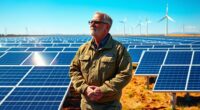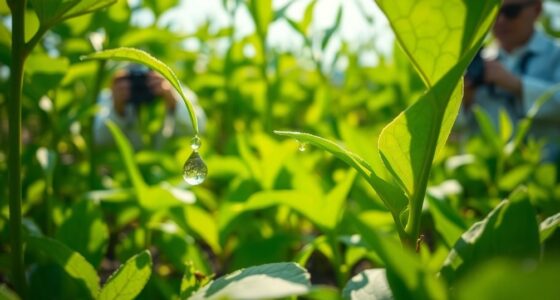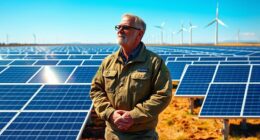Climate change worsens the wildfire crisis in the West by lengthening fire seasons, drying out fuels, and increasing temperatures that make fires more intense. Drier conditions and drought cause earlier snowmelt and reduced rainfall, creating abundant, easily ignitable fuels. Human activities and infrastructure failures also add to the risk. If you stay informed, you’ll discover how land management and community efforts can help fight these devastating mega-fires.
Key Takeaways
- Rising temperatures cause earlier snowmelt and drier conditions, increasing wildfire risk and severity in Western U.S. forests.
- Prolonged drought dries fuels like grasses and shrubs, making large mega-fires more likely and harder to control.
- Climate change has extended wildfire seasons by over a month, leading to more frequent and intense fires annually.
- Reduced summer rainfall and warmer nights contribute to drier ecosystems, amplifying fire spread and destructive potential.
- Historic fire suppression has built fuel loads, which, combined with climate change, significantly raises mega-fire risks.
The Changing Climate and Its Impact on Wildfire Seasons

Climate change has considerably extended wildfire seasons in the Western U.S., with recent data showing they now last over a month longer than they did 35 years ago. Rising temperatures cause earlier snowmelt, leading to drier conditions earlier in the year. Warmer nights and reduced summer rainfall further dry out forests and grasslands, increasing fire risk. Human activities, such as land development and resource extraction, are the primary drivers behind worsening fire weather conditions. Decreased summer precipitation correlates strongly with larger burned areas each year. Historic wildfire suppression efforts have also contributed by building up fuel loads, which, combined with hotter, drier climates, intensify fire severity. These factors create longer, more destructive fire seasons that threaten ecosystems, communities, and economies across the West. Additionally, discolored, dry, and separated vegetation, often a sign of prolonged drought stress, provides additional fuel that exacerbates wildfire severity and spread, especially when combined with drought conditions that are worsening due to climate change. Furthermore, fuel buildup from years of suppression has made some forests more susceptible to large, uncontrollable fires when conditions become extreme. This combination of factors emphasizes the urgent need for sustainable forest management practices to reduce wildfire risks.
The 2025 Wildfire Season: A Record-Breaking Year

The 2025 wildfire season has been one of the most destructive on record, with over 44,470 fires burning nearly 4 million acres nationwide by November. Early fires surged in California’s Sierra Nevada foothills and Oregon’s Cascades, with many exceeding 10,000 acres by summer’s start. Firefighting efforts reached record levels, deploying extensive resources to contain the flames. The season saw over 30 fatalities in California alone, along with thousands of structures lost. Persistent drought, combined with rising temperatures and human activity, fueled rapid fire spread and increased severity. The increasing use of encryption software and hardware in firefighting communications has helped coordinate efforts more effectively. Despite some late-year rainfall providing brief relief, drought conditions persisted across many Western states. Overall, 2025 marked a year of unprecedented fire activity, highlighting how climate change amplifies wildfire risks and challenges. Additionally, the increasing frequency of extreme weather events contributes to the unpredictability and intensity of fires, making preparedness even more critical. The behavior of wildfires is also influenced by changing climate patterns, intensifying the need for adaptive fire management strategies.
Drought, Fuels, and the Rising Threat of Mega-Fires
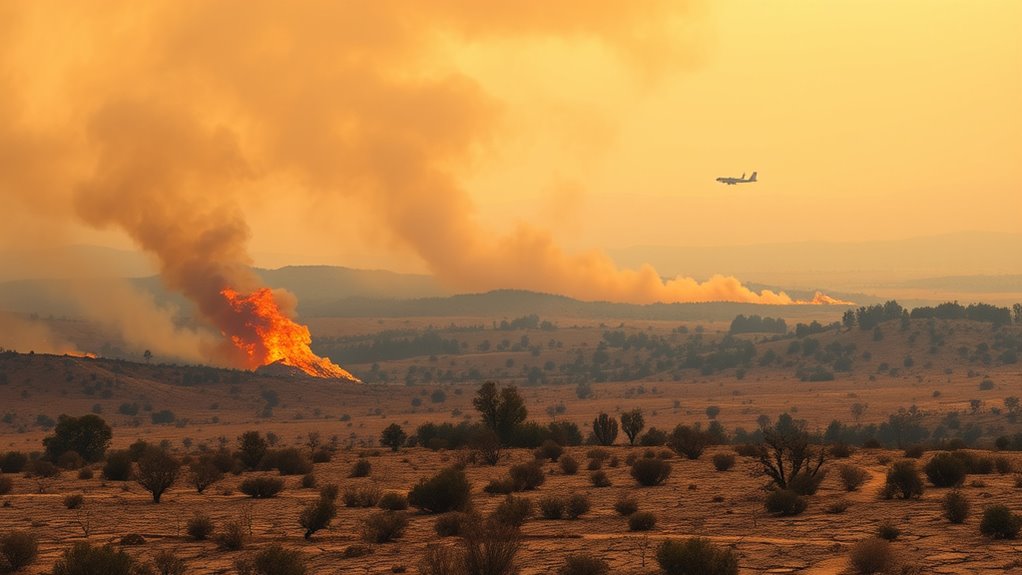
Persistent drought conditions across the Western U.S. markedly increase wildfire risks by drying out fuels like grasses, shrubs, and forest understory. When these materials become parched, they turn into highly combustible fuels that ignite easily and spread rapidly. Hot temperatures and low humidity further intensify this danger, making wildfires more intense and harder to control. After wet springs, dried-out vegetation creates abundant fuel for mega-fires, especially when ignited by human activity or natural causes. In 2025, drought zones in California, Arizona, and Wyoming fueled some of the largest fires, while uneven precipitation patterns left many areas vulnerable. As fuels dry and accumulate, the potential for large, destructive mega-fires grows, demanding urgent attention to land management and fire prevention strategies. Recognizing the importance of land management practices and community cooperation can significantly enhance fire mitigation efforts and safety protocols. Additionally, implementing sustainable fire prevention techniques can help reduce the severity and frequency of these devastating wildfires. Incorporating protective styling benefits such as controlled burns and fuel management can further decrease wildfire risks and promote healthier ecosystems.
Human Factors and the Spread of Wildfires

Human activities play the dominant role in the increasing spread and severity of wildfires across the Western U.S. You may not realize it, but everyday actions—like discarded cigarettes, unattended campfires, or vehicle sparks—can ignite massive fires. Urban-wildland interface areas are especially vulnerable, with more homes built near forests, increasing ignition risks. You might also contribute indirectly through infrastructure failures, such as power lines sparked by wind or storms. Fire suppression policies over decades have led to fuel buildup, making fires more intense when they occur. Additionally, climate-driven conditions, combined with human activities, create a perfect storm for rapid fire spread. Understanding your role and reducing risky behaviors can help prevent some fires, but systemic changes are essential to curb wildfire severity nationwide. Fuel buildup from decades of suppression efforts has significantly increased the potential for destructive mega-fires, emphasizing the importance of fire management practices that restore natural fire cycles. Moreover, adopting prescribed burns and other preventative strategies can help reduce excess fuels and mitigate wildfire risks in vulnerable ecosystems. Implementing community education programs can also raise awareness about fire risks and promote safer behaviors. Increasing awareness and implementing wildfire mitigation strategies at community and policy levels are critical steps toward reducing the devastating impacts of these fires.
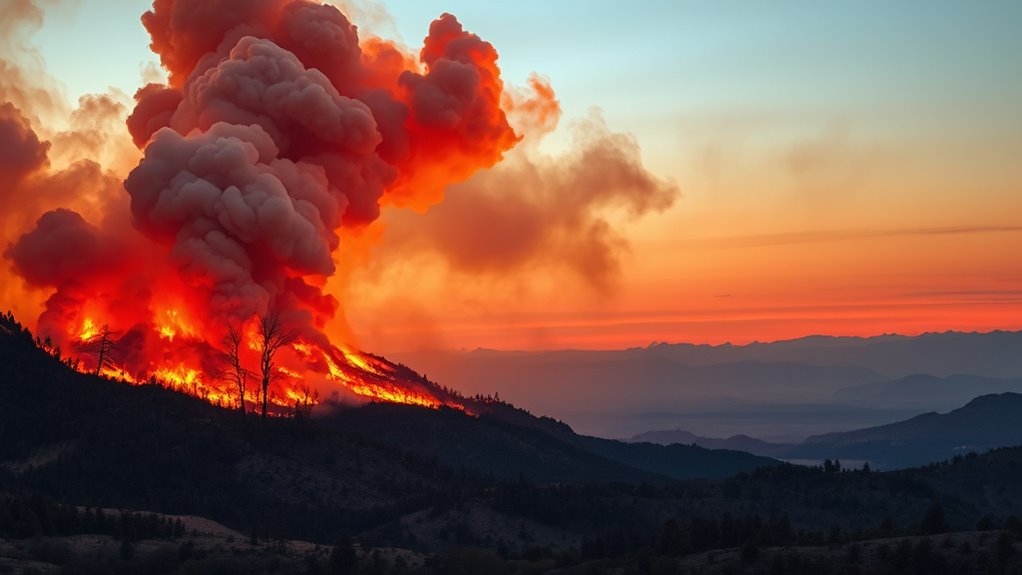
Effective wildfire management requires adapting strategies to the changing climate and evolving fire behaviors. You need to prioritize flexible approaches like targeted prescribed burns and mechanical thinning, even when weather conditions are challenging. Stay informed about forecasted fire weather and drought conditions to plan proactively. Community engagement is essential; you should educate residents about defensible space and evacuation plans. Invest in advanced firefighting technologies, such as remote sensing and real-time monitoring, to improve response times. Building resilient infrastructure and land-use policies can reduce long-term risks. Collaboration among agencies, scientists, and local communities is crucial to develop holistic fire management plans. By integrating climate adaptation into policies and practices, you can better protect lives, property, and ecosystems from future mega-fires. Additionally, understanding the contrast ratio of firefighting equipment and infrastructure can help improve visibility and safety during nighttime operations. Recognizing the importance of wildfire mitigation techniques, such as fuel breaks and controlled burns, can further enhance community resilience. Implementing sustainable land management practices is vital to reduce fuel loads and prevent the spread of wildfires. Incorporating dynamic communication exercises can also promote better coordination among response teams and community members, ensuring swift action when emergencies arise. Strengthening the capacity for private placement equity markets in key sectors can support investments in fire-resistant infrastructure and innovative mitigation solutions.
Frequently Asked Questions
How Do Wildfire Suppression Policies Influence Long-Term Fire Risk?
Wildfire suppression policies often increase long-term fire risk by preventing natural fires from clearing out flammable fuels. When you suppress fires, fuel loads build up, making future fires more intense and harder to control. This creates a dangerous cycle where fires become larger and more destructive over time. To reduce risk, you need to balance suppression with strategic fuel management, allowing some fires to burn safely under controlled conditions.
What Role Do Invasive Species Play in Wildfire Fuel Accumulation?
Invasive species markedly spike wildfire severity by spreading swiftly and supplying abundant, easily ignitable fuels. They outcompete native plants, creating dense, dry, and combustible landscapes. You’ll see invasive grasses, shrubs, and trees thrive, turning forests and grasslands into tinderboxes. Their rapid, relentless growth fuels flames, making fires fiercer and more frequent. Managing these invasive invaders is vital to curbing wildfire risks and restoring natural resilience to vulnerable ecosystems.
How Does Urban Development in Fire-Prone Areas Affect Wildfire Severity?
You increase wildfire severity when you develop in fire-prone areas because it puts more structures and people at risk. Urban expansion near forests creates more ignition sources, like infrastructure failures or human activities. Plus, these developments can hinder firefighting efforts, making it harder to control fires. As a result, fires spread faster, burn larger areas, and cause more damage, highlighting the need for careful planning and fire-resistant building practices in these vulnerable zones.
Can Technological Advances Improve Wildfire Prediction and Early Warning Systems?
Technological advances can markedly enhance wildfire prediction and early warning systems, helping you stay ahead of potential threats. You’ll benefit from improved satellite monitoring, real-time data analysis, and smarter modeling tools that forecast fire behavior more accurately. These innovations enable quicker response times, better resource allocation, and timely alerts, giving you a critical edge in protecting lives, property, and ecosystems from the increasing severity of wildfires driven by climate change.
What Are Effective Community Strategies for Wildfire Preparedness and Resilience?
You can improve your wildfire preparedness by creating defensible space around your home, clearing dead vegetation, and using fire-resistant materials. Stay informed with local alerts and develop an evacuation plan with your family. Participate in community efforts like neighborhood watch programs and support local fire mitigation projects. Educate yourself on fire risks specific to your area and advocate for policies that enhance community resilience and emergency response.
Conclusion
As you watch these megafires grow more uncontrollable, it’s ironic that our efforts to protect land often worsen the problem. Climate change fuels the flames, yet we still hesitate to make the bold changes needed. You might think we’d learn, but instead, we keep playing with fire—literally. So, as the smoke rises, remember: ignoring the crisis only guarantees it’ll burn even brighter, leaving us all to face the ashes of our inaction.

